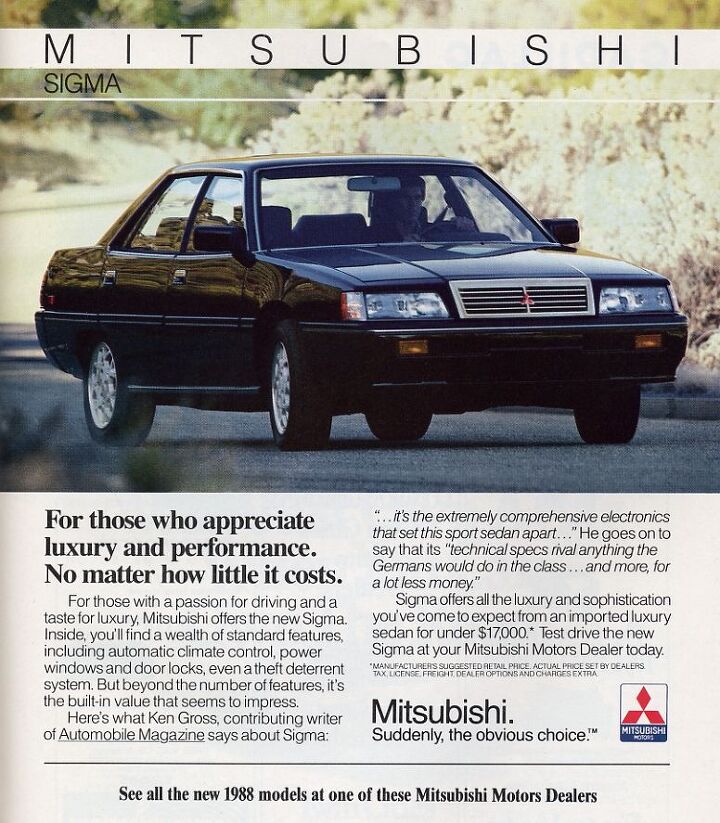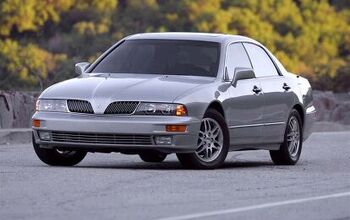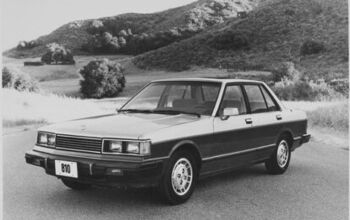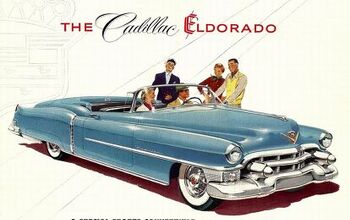Rare Rides Icons: The Mitsubishi Diamante Story (Part I)

Rare Rides Icons has featured much Japanese sedan content lately, including the mid-Eighties sedan mainstays and most recently a series on the luxurious and conservative Toyota Cressida. However, there’s a mainstream Japanese brand (or two) yet to be included in our sedan considerations. One of them is Mitsubishi, and today we’ll discuss the only true upmarket product the company ever offered in North America. It’s Diamante time.
Mitsubishi had humble North American beginnings in 1971 when it provided rebadged economy cars as Colts to Dodge and Plymouth dealers. By the early Eighties, it established its own US dealership network to sell a couple of its smaller models. From there, the slow flow of Cordias and Tredias grew into a full lineup of vehicles by the middle of the decade. And what’s a full lineup without a luxurious sedan? As per usual, we start our discussion with some detail about what came before Diamante: The Sigma.
Introduced in the US for the 1988 model year, the compact Sigma was the upmarket sedan placed above the Galant, also a compact at the time. It fit into the lineup far above the subcompact Mirage and Precis and joined just as the sporty compact Cordia was put out to pasture. Underneath the Sigma was the Galant that Mitsubishi introduced to North America for 1985. The Galant name was a long-running one at Mitsubishi, in use since 1969 (as Colt Galant). But the Sigma name didn’t appear until the model’s third iteration in 1976. It was called Galant Σ (for Sigma) in Japan but was often marketed as Galant in other markets, or even Colt in its wagon format in North America.
1980 brought a fourth-generation Galant Σ, which was also branded as Eterna Σ. It was a time when Mitsubishi consolidated the number of things that wore Galant badges. Export markets received the car as the Galant, except for Australia and New Zealand where it was just called Sigma. All Galant versions were still rear-drive, and the two-door hardtop (Galant λ) was cynically offered as the Dodge Challenger and Plymouth Sapporo in North America (much to the chagrin of real Challenger fans). The fourth-generation Sigma remained in production through 1987 for certain markets but was eclipsed (hah) and supplemented by a front-drive fifth-generation Galant in 1983.
It was this fifth-gen car that arrived as the Galant sedan in 1985 and set the stage for the arrival of the Sigma. While the Galant was available only as a pedestrian four-door (on this continent), when the Sigma arrived in 1988 (as Galant Σ) it wore a more exclusive hardtop body style. There were frameless windows, a more formal chrome grille, and nicer alloys than were available on the Galant. The Galant Σ offered a standard 3.0-liter V6 that was not available on the regular Galant and was only motivated by a four-speed automatic. Mitsubishi did make a full-size luxury car at the time, the Debonair, but it was exported only to select right-hand drive markets. One might replicate Debonair’s driving experience via a Dodge Dynasty, though.
Other differences on Galant Σ were limited to the upscale and ruched interior, even though Mitsubishi marketed the very exclusive Galant with an Σ badge as separate to the Galant. The initial Sigma strategy was only a temporary measure, as 1989 brought an interesting development: An all-new Galant. The Galant entered its second North American generation in 1989 (the sixth Galant overall). Though it was on the same front-drive platform as before, the new Galant looked much more modern and aerodynamic. The much more expensive Sigma was still the old Galant Σ. But now it wore a revised name and forewent Greek lettering. The rear deck said “Sigma” in block letters, though little else changed that year aside from a new alloy design.
The new Galant took off in sales and was named Motor Trend Import Car of the Year in 1989, while the very old-looking Sigma languished and sold very few examples. In 1989 it was available in one fully-loaded trim, at an ask of $17,294 ($40,150 adj.). For reference, a Camry LE V6 asked $16,428 ($38,139 adj.) that year, while a Nissan Maxima was $18,824 ($43,702 adj.) in its top SE trim. Both those cars were larger than the Sigma, newer, and had a more established reputation. Sigma returned again in 1990, as a last-of-moment for the era when the Sigma and its lesser Galant sibling were tied together. It looked the same as before in export markets, but Mitsubishi saw fit to update it elsewhere with a mild facelift and some new naming, Eterna Σ.
Mitsubishi knew it needed to try a little harder to make any headway with an upmarket sedan in export markets where it was still a relatively new player. It needed a larger car, a true midsize. The new car also needed to be more modern, and more competitive with other upscale Japanese sedans. Though 1990 was the final year for the Sigma in the US, its replacement wasn’t quite ready for a prime-time global release.
Said replacement debuted at the Tokyo Motor show of 1989, and went on sale exclusively in the Japanese market in May of 1990. It had an all-new name: Diamante. That name was for the majority of markets, though some still received it as Sigma. There were three body styles globally, but none would arrive in the North American market until 1992. Meantime, Mitsubishi dealers in the US (no Mitsubishi in Canada until 2002) sat tight as the largest car Mitsubishi offered was the Galant.
[Images: Mitsubishi, YouTube]

Interested in lots of cars and their various historical contexts. Started writing articles for TTAC in late 2016, when my first posts were QOTDs. From there I started a few new series like Rare Rides, Buy/Drive/Burn, Abandoned History, and most recently Rare Rides Icons. Operating from a home base in Cincinnati, Ohio, a relative auto journalist dead zone. Many of my articles are prompted by something I'll see on social media that sparks my interest and causes me to research. Finding articles and information from the early days of the internet and beyond that covers the little details lost to time: trim packages, color and wheel choices, interior fabrics. Beyond those, I'm fascinated by automotive industry experiments, both failures and successes. Lately I've taken an interest in AI, and generating "what if" type images for car models long dead. Reincarnating a modern Toyota Paseo, Lincoln Mark IX, or Isuzu Trooper through a text prompt is fun. Fun to post them on Twitter too, and watch people overreact. To that end, the social media I use most is Twitter, @CoreyLewis86. I also contribute pieces for Forbes Wheels and Forbes Home.
More by Corey Lewis
Latest Car Reviews
Read moreLatest Product Reviews
Read moreRecent Comments
- ToolGuy The only way this makes sense to me (still looking) is if it is tied to the realization that they have a capital issue (cash crunch) which is getting in the way of their plans.
- Jeff I do think this is a good thing. Teaching salespeople how to interact with the customer and teaching them some of the features and technical stuff of the vehicles is important.
- MKizzy If Tesla stops maintaining and expanding the Superchargers at current levels, imagine the chaos as more EV owners with high expectations visit crowded and no longer reliable Superchargers.It feels like at this point, Musk is nearly bored enough with Tesla and EVs in general to literally take his ball and going home.
- Incog99 I bought a brand new 4 on the floor 240SX coupe in 1989 in pearl green. I drove it almost 200k miles, put in a killer sound system and never wish I sold it. I graduated to an Infiniti Q45 next and that tank was amazing.
- CanadaCraig As an aside... you are so incredibly vulnerable as you're sitting there WAITING for you EV to charge. It freaks me out.







































Comments
Join the conversation
I have a friend who has a 1996 Diamante wagon, who still uses it as a daily driver. These were built in Australia by Mitsubishi and exported here.
Second gen Diamante was, in the context of its time, a very nice car with some real luxury-boat chops.